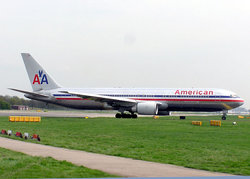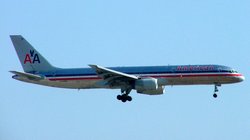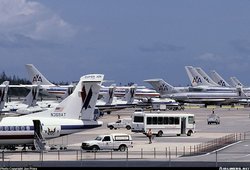American Airlines
|
|
Note: For the arenas named after this company, see American Airlines Arena (Miami, Florida), or American Airlines Center (Dallas, Texas).
American Airlines (AA) Template:NYSE is the largest airline in the world in terms of total passengers transported, and the second-largest airline in the world (behind Air France-KLM) in terms of total operating revenues. It is headquartered in Fort Worth, Texas, and operates scheduled flights throughout the United States, as well as flights to Latin America, Western Europe and Japan. Since 1982, AA has been a subsidiary of the AMR Corporation. AMR was named after the old American Airlines NYSE ticker symbol, which AMR still has today. AMR Corporation also owns 2 commuter airlines: American Eagle, and Executive Air (American's other commuter affiliate, American Connection, is independent of AMR). The chairman and CEO of AMR and AA is Gerard Arpey.
By many measures, including passenger traffic, fleet size, and number of employees, American is the largest airline in the world. As of October 2004, AMR Corp. served 172 cities with a fleet of 996 aircraft (710 AA aircraft and 286 American Eagle aircraft) handling 80 million passengers a year with an average of 2,600 daily departures. American carries more passengers between the US and Latin America (12.1 million in 2004) than any other airline, and is also strong in the transcontinental and US-UK markets.
American has five hubs: Dallas/Fort Worth, Chicago O'Hare, Miami, San Juan, and St. Louis. American also has major operations at Boston, New York LaGuardia and JFK, and Los Angeles. It operates maintenance bases at Tulsa, Kansas City, and Fort Worth Alliance.
American is a founding member of the Oneworld airline alliance.
| Contents |
History
American Airlines developed from a conglomeration of about 82 small airlines companies through a series of corporate acquisitions and reorganizations: initially, the name American Airways was used as a common brand by a number of independent air carriers. In 1934, American Airways Company, in financial straits, was acquired by E.L. Cord, who renamed the company "American Airlines". Early in its history, the company was headquartered at Midway Airport in Chicago. American's innovations during this period included the introduction of flight attendants.
American_DC-3.jpg
The main American Airlines route until the late 1950s was from New York and Chicago to Los Angeles via Dallas. One of the early American Airlines presidents, C.R. (Cyrus Rowlett) Smith, worked closely with Donald Douglas to develop the DC-3, which American Airlines started flying in 1936. With the DC-3, American began to brand itself using nautical terms, calling its aircraft "Flagships" and establishing the "Admirals Club," which was initially an honorary club for valued passengers and later became the world's first airline lounge (at LaGuardia Airport). The DC-3s had a four-star "admiral's pennant" which would fly outside the cockpit window while the aircraft was parked, one of the most well-known images of the airline at the time.
After World War II, American launched an international subsidiary, American Overseas Airways to serve Europe; however, AOA was sold to rival Pan Am in 1948. AA also launched flights to Mexico in the 1940s, and built several airports in northern Mexico to serve as diversion points for aircraft bound for Mexico City.
With the introduction of 707 "Astrojet" service in the 1960s, American's focus shifted to nonstop coast-to-coast flights, although it maintained feeder connections to other cities along its old route using smaller Convair 990s and Lockheed Electras. During the 1970s, American acquired its first Boeing 747s and began flights to Australia and New Zealand, although it traded these routes to Pan Am in 1975 in exchange for routes to the Caribbean.
Following a financial slump in the 1970s under the leadership of former general counsel George Spater, American hired Robert Crandall as its CEO, who introduced many innovations including the world's first frequent flyer miles (AAdvantage) and corporate travel card (AAirpass). After discovering several thousand unused CRT terminals in a Tulsa hangar, Crandall ordered them refurbished and provided to travel agents, creating the first airline-owned agent-accessible computer reservations system.

In the meantime, American Airlines had moved its corporate headquarters from New York City to Fort Worth, Texas in 1979 (under provisional CEO Al Casey), and changed its routing to a spoke-hub distribution paradigm starting in 1981, opening its first hubs in Dallas/Ft Worth and Chicago. American began flights to Europe and Japan from these hubs in the mid-1980s. In the late 1980s, American opened three new hubs for north-south traffic, in Nashville, San Jose (added in the purchase of Air California), and Raleigh/Durham. All three were abandoned in the mid-1990s in favor of expanded service at Miami, which became a hub after American bought Central and South American routes from Eastern Airlines in 1990.
Crandall left the company in 1998 and was replaced by Donald J. Carty, who negotiated the purchase of Trans World Airlines and its hub in St. Louis in 2001. In the wake of the TWA merger and the roughly concurrent September 11 attacks (which claimed two of AA's aircraft), American began losing money. Carty negotiated new wage and benefit agreements with the airline's labor unions, but was forced to resign after union leaders discovered that Carty was planning to award handsome executive compensation packages at the same time. St. Louis' hub was also dismantled afterwards.
In Carty's wake, American has undergone additional cost-cutting measures, including rolling back its "More Room in Coach" program (which eliminated several seats on certain aircraft types), ending three-class service on many international flights, and standardizing its fleet at each hub (see below). However, the airline has rebounded and expanded its service into new markets, including Ireland and western Japan. In 2005, AA received FAA approval to serve Shanghai from Chicago O'Hare beginning April 2, 2006, its first expansion into Asia since an abortive attempt to serve Taipei in mid-2001.
Pop culture
- In the 1960s, Mattel released a series of American Airlines stewardess Barbie dolls.
- An American Airlines Space Freighter, the Valley Forge, was the setting for the 1971 science fiction movie Silent Running, starring Bruce Dern and directed by Douglas Trumbull.
- AA was featured prominently in the first two Home Alone movies.
- In the early 1990s, singer Janet Jackson made a commercial for AA.
- AA has been a long-time promotional sponsor of The Oprah Winfrey Show, broadcast from AA's hub city of Chicago.
- AA is one of the few companies to have purchased naming rights for two sporting venues: the American Airlines Arena in Miami and the American Airlines Center in Dallas.
Famous disasters
- American Airlines Flight 320, a Lockheed L-188 Electra, crashed on approach to LaGuardia on February 3, 1959 due to pilot error.
- American Airlines Flight 625, a Boeing 727, crashed on approach to St. Thomas, U.S. Virgin Islands on April 27, 1976.
- American Airlines Flight 191, a McDonnell Douglas DC-10, crashed at O'Hare Airport on May 25, 1979.
- American Airlines Flight 965, a Boeing 757, crashed on approach to Cali, Colombia, on December 20, 1995.
- American Airlines Flight 1420, a McDonnell Douglas MD-80, crashed on landing to Little Rock, AR on June 1, 1999.
- Two American Airlines aircraft were hijacked and crashed during the September 11, 2001 Terrorist Attack: Flight 77 (a Boeing 757) and Flight 11 (a Boeing 767).
- American Airlines Flight 587 crashed in New York City on November 12, 2001.
- American almost lost Flight 63 to "shoe bomber" Richard Reid on December 22 of the same year, but the plot was foiled. The flight was enroute from Paris De Gaulle to Miami, and was diverted to Boston's Logan Airport.
- Corporate Airlines Flight 5966, an affiliate of American through the American Connection alliance crashes in Missouri killing 13 people.
Livery
American's early liveries varied widely, but a common livery was adopted in the 1930s that featured a large eagle painted on the fuselage of each aircraft. The eagle became a widely-recognized symbol of the company and inspired the name of American Eagle Airlines. Propeller aircraft featured an international orange lightning bolt running down the length of the fuselage, which was replaced by a simpler orange stripe with the introduction of jets.
In the late 1960s, American commissioned an industrial designer to develop a new livery. The original design called for a red, white, and blue stripe on each aircraft's fuselage, and a simple "AA" logo, sans eagle, on the tail. However, American's employees revolted when the livery was made public, and launched a "Save the Eagle" campaign similar to the "Save the Flying Red Horse" campaign at Mobil. Eventually, the designer caved in and created a highly stylized eagle, dubbed "the bug," which remains the company's logo to this day.
For many years, American was the only major U.S. airline that left the majority of its aircraft surfaces unpainted. Originally, this was because C. R. Smith hated painted aircraft, and refused to use any liveries that involved painting the entire plane. Crandall later justified the bare-metal design by noting that less paint reduced the aircraft's weight, thus saving on fuel costs.
Fleet
American.b777.rearview.arp.750pix.jpg
American operates a relatively old fleet, with an average age of 10.5 years [1] (http://www.airsafe.com/events/airlines/fleetage.htm). Almost half of its fleet is comprised of McDonnell Douglas MD-80 twinjets, many of which date back to the early 1980s. However, most of AA's aircraft have been refitted with new interiors in the last few years, with the exception of many Boeing 757s. AA has also introduced many new aircraft to its fleet: the newest are the Boeing 777s, which replaced MD-11s on key transoceanic routes in the late 1990s, and Boeing 737s, which replaced 727s on some domestic and Caribbean routes.
American has discontinued three-class service on most aircraft, but continues to offer business class on 777 and 767-200 aircraft. First class passengers on 777 routes to London and Frankfurt enjoy the "American Flagship Suite," a first class seat that can swivel inwards toward a personal work area and also recline 90 degrees to become a bed. 767-200 flights between JFK, SFO, and LAX offer three-class "American Flagship Service" which replicates the passenger service offered on long international flights.
Most recently, American has taken the unique step of redesigning its schedules so that each hub city receives certain aircraft types more often than others, which is intended to simplify maintenance and last-minute fleet substitutions. Currently, Chicago and DFW get most MD-80 service, Miami gets most 757 and 737 service, and JFK gets most A300 and 767-200 service.
| Type | Fleet | Seats, layout | Routes |
|---|---|---|---|
| Boeing 777-223ER | 45 | 236 (16/35/194) 238 (18/42/163) | London, Frankfurt Japan, Brazil, Argentina, some domestic services |
| Airbus A300-600R | 34 | 266 (16/250) | High-density, medium-range trunk routes to the Caribbean and along the East Coast |
| Boeing 767-323ER | 58 | 213 (30/183) | Long-haul routes to Europe, Hawaii, and Latin America, premium transcontinental, some hub-to-hub ferrying flights |
| Boeing 757-223 | 143 | 188 (22/166) 188 (0/188) | Domestic, Caribbean, and Latin American flights ; service from Boston to Manchester and Shannon |
| Boeing 767-223 | 16 | 158 (9/30/119) | Service from JFK to Bermuda, Los Angeles, Miami, and San Francisco. |
| Boeing 737-823 | 77 | 142 (16/126) | Domestic, Caribbean, and Latin American flights |
| McDonnell Douglas MD-80 | 337 | 129 (14/115) 131 (16/115) | Domestic flights, predominantly east-west flights through DFW and Chicago |
In the past, American has operated a wide variety of aircraft types, including:
- BAC 111 (1960s-70s)
- BAe 146 (1980s)
- Boeing 707 (1950s-70s)
- Boeing 727-123 (1970s-80s)
- Boeing 727-223 (1970s-90s)
- Boeing 737-223 (1980s)
- Boeing 747-123 (1970s-80s) (one was later used as Shuttle Carrier Aircraft)
- Boeing 747SP (1970s-80s)
- Convair 240 (1950s-60s)
- Convair 990 (1970s)
- Curtiss Condor (1920s-30s)
- Douglas DC-2 (1930s)
- Douglas DC-3 (1930s)
- Douglas DC-4 (1940s)
- Douglas DC-6 (1940s)
- Douglas DC-7 (1950s)
- Fokker F100 (1980s-2004)
- Ford 5-AT-B Trimotor (1920s)
- Lockheed L-188 Electra (1950s-60s)
- McDonnell Douglas DC-10 (1970s-90s)
- McDonnell Douglas MD-11 (1990s)
Destinations
See full article: American Airlines destinations
Codesharing agreements
American currently has codesharing agreements with Aer Lingus, Air Pacific, Alaska Airlines, British Airways, Cathay Pacific Airways, China Eastern Airlines, Deutsche Bahn, EVA Air, Finnair, Grupo TACA, Hawaiian Airlines, Iberia, Japan Airlines, LAN Chile, Mexicana, Qantas Airways, Singapore Airlines, SN Brussels Airlines, SNCF, Swiss International Air Lines, TAM Airlines, Gulf Air, and Turkish Airlines. American Connection, which feeds American's former hub at Lambert Saint Louis International Airport, is also a codesharing operation with three regional carriers.
Diversity
American received a 100% rating on the first Corporate Equality Index released by the Human Rights Campaign in 2002 and has maintained their rating in respect to policies on LGBT employees.
Sources
- John M. Capozzi, A Spirit of Greatness (JMC, 2001), ISBN 0965641031
- Don Bedwell, Silverbird: The American Airlines Story (Airways, 1999), ISBN 0965399362
- Al Casey, Casey's Law (Arcade, 1997), ISBN 1559703075
- Simon Forty, ABC American Airlines (Ian Allan, 1997), ISBN 1882663217
- Dan Reed, The American Eagle: The Ascent of Bob Crandall and American Airlines (St. Martin's, 1993), ISBN 0312086962
- Robert J. Serling, Eagle (St. Martin's, 1985), ISBN 0312224532
- International Directory of Company Histories, St. James Press.
External links
- American Airlines (http://www.aa.com/)
- Yahoo! - AMR Corporation Company Profile (http://biz.yahoo.com/ic/10/10021.html)
- American Airlines C.R. Smith Museum (http://www.crsmithmuseum.org/)
- Historical timetables and route maps (http://www.airchive.com/SITE%20PAGES/TIMETABLES-AMERICAN.html)
- American Way (http://www.americanwaymag.com/), American's inflight magazine
- American Airlines crashes (http://www.airdisaster.com/cgi_bin/airline_detail.cgi?airline=American+Airlines)
| Members of the oneworld Alliance | 
| |
|
Aer Lingus | American Airlines | British Airways | Cathay Pacific | Finnair | Iberia Airlines | Lan | Qantas |
|
Lists of Aircraft | Aircraft manufacturers | Aircraft engines | Aircraft engine manufacturers Airports | Airlines | Air forces | Aircraft weapons | Missiles | Timeline of aviation |
el:Αμερικανικές Αερογραμμές es:American Airlines fr:American Airlines ja:アメリカン航空 pt:American Airlines



